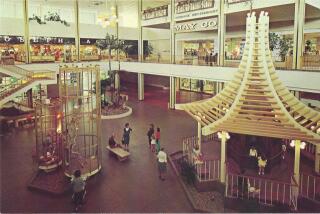DECORATING : Factory Outlets Help Shoppers Stretch Budgets
- Share via
While sales at traditional furnishings stores remain a good resource for bargain hunters, shoppers today are also turning to the growing number of factory outlet malls to stretch their budgets.
Henredon furniture, Reed & Barton silver, Lenox china, Alessi teapots, Anichini linens or Waverly fabrics, Crate & Barrel, Williams-Sonoma, Dansk and Laura Ashley are among numerous manufacturers with multiple discount locations. Even Sony and Magnavox have jumped into the outlet mainstream.
In 1992, the nation’s more than 300 outlet centers reported annual sales of $8.5 billion, up from $7.4 billion in 1991, according to Dawn Frankfort, editor of The Joy of Outlet Shopping.
She estimates that discounts range from 20% to 80%.
By the end of 1993, outlet stores are expected to total more than 9,000 around the country, double the number that existed in 1989, predicts Randy Marks, editor of Outlet Bound. And, although apparel manufacturers make up about 80% of the industry, quality home-furnishings makers are coming on strong.
“Some of the surveys have suggested that outlets have an affluent, upscale client--and a greater percentage of people earning $75,000 or more are shopping at outlets,” Marks says.
Gone, for the most part, are the barnlike spaces where determined bargain hunters pawed through rack after rack of merchandise. Most of today’s outlets have specialty-store ambience, “village” settings and services such as mail order, custom upholstery, return policies, toll-free numbers and--quite often--first-run products.
In addition to first-quality overruns, shoppers will likely find merchandise considered seconds, samples and prototypes, as well as items discontinued and made only for outlet sale.
Usually, seconds have quality-control flaws--such as a pulled thread, slight stain or color that is a bit off. Prototype pieces may be tests of colors, patterns or materials. Samples may come from a trade show or showroom. “Lots of manufacturers try new ideas. Occasionally, you might just find a sample corner in some of these stores where different things are tested,” Marks says.
“As long as you stick with the major brands, you have recourse down the line,” he says. “The outlet industry has a lot of quality brands behind it. Anybody selling junk doesn’t last very long.”
Consumers can credit the recent recession, in part, to the outlet boom. As a weak economy squeezed retailers, manufacturers used liquidators and discounters to market unsold stock, but realized a mere 10 to 30 cents on the dollar. Factory-direct outlets, eliminating the middleman, offer a better return and more inventory control, although manufacturers try to keep outlets low-profile.
“Traditionally, they don’t want to disturb the retail clients they’re presently selling to at wholesale. We call that the sensitivity issue, and that’s one reason you don’t really see factory outlets advertise all that much,” Marks says. “Also, by keeping it somewhat hush-hush, it kind of adds to the mystique of the whole thing.”
For shoppers who want to flex their power-shopping muscle in the outlet arena, Marks offers some tips for making the most of the trip:
Is the store a genuine factory-direct outlet? If it is selling one brand, or a few brands, of merchandise, it probably is. If it “sells anything under the sun,” he says, it probably is not. Ask the manager to be sure.
Shop smart. Comparison-shop at traditional retailers first to recognize outlet value.
Stop first at the outlet’s clearance section. “Everybody has a corner or a rack or a table of items reduced to the max--up to 90% off. That’s where you find the best values,” Marks says.
More to Read
Inside the business of entertainment
The Wide Shot brings you news, analysis and insights on everything from streaming wars to production — and what it all means for the future.
You may occasionally receive promotional content from the Los Angeles Times.










